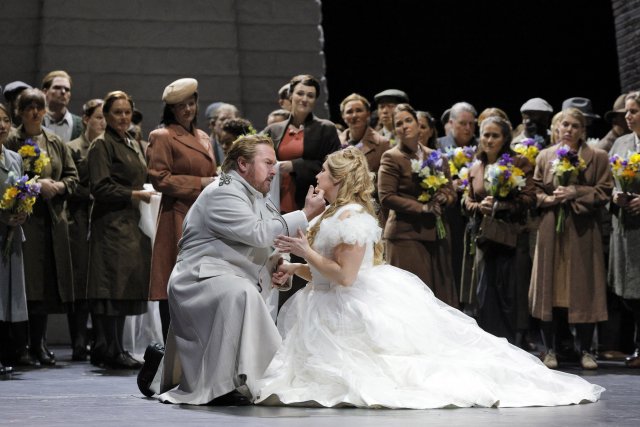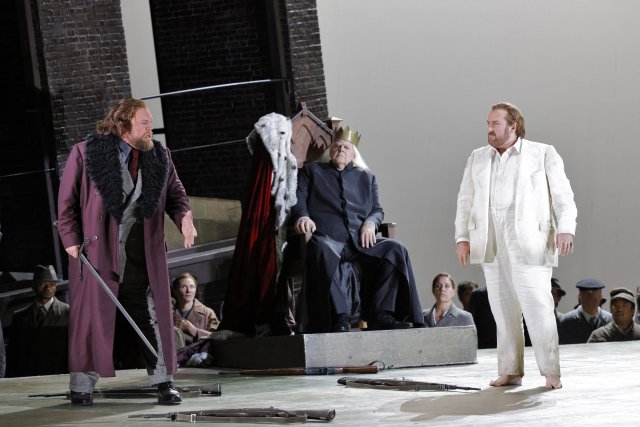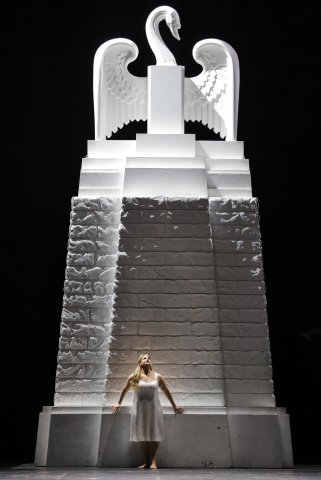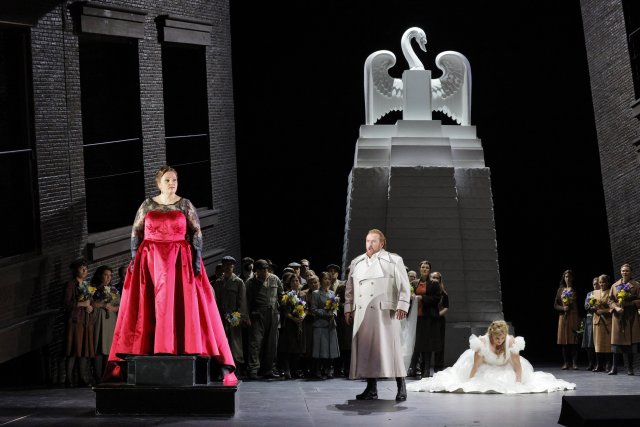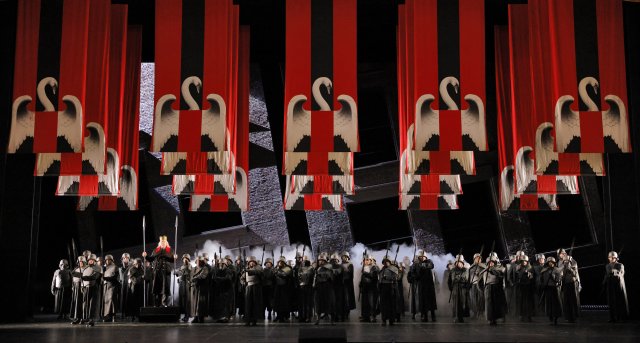Lohengrin
A Compelling but Foreboding Realization by San Francisco Opera
By: Victor Cordell - Oct 17, 2023
“Lohengrin” had been one of the few major operas that Karin, my wife/editor, and I had not seen. As we approached War Memorial Opera House, she observed that she expected to either love or hate it. Certainly, Wagner’s epic operas divide aficionados, and there are sufficient criteria for dissatisfaction with either the composition itself or any particular production which must conquer numerous challenges. While differences of opinion will be noted, make no mistake, San Francisco Opera’s realization is world class, ideally cast, provocative, and completely worthy. And though it clocks in at nearly 4 ½ hours, even most short-fused detractors will find it captivating.
This opera holds a special place in Wagner’s canon, as the apotheosis of his Romantic period and the launch point for his magnum opus, the four-opera music drama, the Ring Cycle. Musically, it departs from previous operatic strictures like set pieces of arias and ensembles. As with much of the composer’s output, “Lohengrin” draws from Norse-Germanic mythology with strong fairy tale elements and moral-religious overtones. The libretto is considered by many to be to be his best plotted. Its breadth is breathtaking with themes of love, fidelity, trust, belief, misogyny, sacrifice, betrayal, revenge, tribalism, militarism, and more.
Although his identity is unknown to the community, the title character arrives in Brabant as a God-sent Knight of the Grail to unify the people of the province and to defend the innocent noblewoman Elsa, being tried for her brother’s murder. To acquit her, the mysterious guest must prevail in combat over Friedrich von Telramund, her lying accuser. The knight marries Elsa with the same condition of faith placed on the Brabantians for his patronage - that she never ask his name or his origins. Indeed, his name and association are not revealed until four hours into the running time of the work.
“Lohengrin” is blessed with beautiful tonal music throughout, beginning with the delicate break-of-day elegance that opens the overture. Although little of the music is memorable, great exceptions are the rousing Prelude to Act 3, which leads into perhaps opera’s greatest contribution to common culture, the wedding processional, known in English as “Here Comes the Bride.” In addition, a recurring leitmotif of several notes will sound familiar because it foreshadows the central melodic line in the music of “Swan Lake.” While Tchaikovsky’s lifting this phrasing may be unexpected, a symbolic connection exists. A swan pilots Lohengrin to Brabant and has visual and transformative prominence in the opera. In less comforting contexts, the swan acts as proxy for the Reichsadler, or German eagle, adopted as a symbol by Nazi Germany.
Music Director Eun Sun Kim conducts the proceedings with her characteristic celerity and aplomb, guiding not only the pit orchestra, principals, and a powerful chorus, but a bevy of off-stage musicians. She has committed to offering a Wagner opera each year (and a Verdi), and her love and appreciation of Wagner’s music comes through clearly in her profound and enthusiastic conducting.
Heading the cast is classic heldentenor Simon O’Neill who has mastered many of the challenging Wagnerian roles. His crisp and edgy tone is especially required to cut through the mellifluous din that Wagner presents for his singers, in this case, an orchestra of 71 musicians and a chorus of 79 voices. Soprano Julie Adams, who is building a resume of both lyric and dramatic roles, joins him as Elsa, and here she gets to show the grit and power in her voice as well as a high tessitura similar to that which O’Neill faces.
Also versatile and a veteran of Wagnerian opera is warm and powerful baritone Brian Mulligan as the antagonist Telramund. Since this is her American debut, few knew what to expect from mezzo Judit Kutasi as Ortrud, Telramund’s wife. Though the part may be anticipated to be secondary, the vile intriguer is instrumental. Kutasi exceeds any expectations with a penetrating voice that is round or cutting depending on the demands, and she inhabits the character’s evil to great effect.
Controversy has always surrounded “Lohengrin.” Nominally written as a solemn Christian fable, from the outset it was criticized as tribal and German nationalistic. It premiered in 1850, when German unification efforts abounded, albeit, that the setting of Brabant was Flanders, or modern-day Belgium. In the 1930s, along with Wagner’s music in general, it was particularly adopted by the Nazis because of its theme of unification through lebensraum (literally “living space,” but more broadly, cross-border expansion) as well as its being emblematic of their culture and purported superiority.
A traditional staging of the work in its historic context renders the opera as distant and somewhat inert – a moral tale that lacks modern consequence. This controversial production is without cuts, so the libretto is unchanged, but Director David Alden has set the visuals in the modern wartime gloom of a presumed Germany. Thus, what may have otherwise seemed innocuous, now appears ominous.
Today, at the real-life time of two threatening regional conflicts - the Russian invasion of Ukraine and the Hamas-instigated rupture between Israel and Gaza - the militaristic aspects of this production particularly resonate. The grimness of the production may not suit all viewers, but this very quality provides its power as well as its fearful reality and relevance.
In its set design, as the curtain rises, sharply drawn light and shadow define the stage along with still characters, evoking a Rembrandt painting and befitting the Low Countries setting. But as light overcomes dark, brooding brick buildings are seen leaning akimbo, suggesting instability and destruction. And except for the highlighted principals, costumery of the multitudes on stage is hued in various shades of depression, indicative of poverty and foreclosed outlook.
The final distress is the depiction of the people’s depravity, which comes in Act 3, when fascist symbols and practices are adopted, including lockstep movements and stylized salutes. Phalanxes of red and black banners with angular graphics and the appropriated graceful white swan in place of the imperial eagle parallel those of Nazi Germany.
In 2016, a theatrical adaptation of Sinclair Lewis’s similarly bleak novel “It Couldn’t Happen Here,” which deals with a fictional fascist takeover in this country through elections, was revived in the Bay Area. Couldn’t it?
“Lohengrin,” with music and libretto by Richard Wagner is produced by San Francisco Opera in association with Royal Opera House – Covent Garden (UK) and Opera Vlaanderen (Belgium), and plays at War Memorial Opera House, 301 Van Ness Ave., San Francisco, CA through November 1, 2023.

